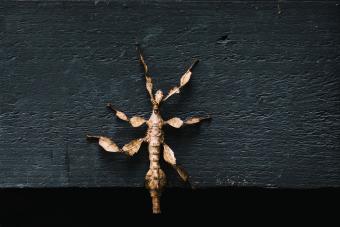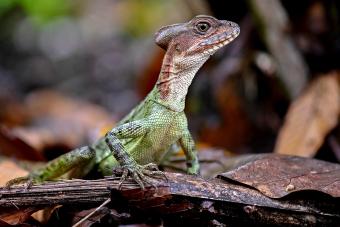
Let's just say it. Stick insects are weird. But seriously, aren't they neat? Plus, they don't require a lot of attention, making them good low-maintenance pets.
Becoming Popular Pets
Stick bugs have become increasingly popular as pets due to their unique appearance, fascinating behavior, and relatively low-maintenance care requirements. They're visually intriguing and tend to be an excellent conversation starter.
They are also well-suited for educational purposes, providing valuable lessons on biology and adaptation. They're excellent pets for both experienced exotic pet enthusiasts and those new to the world of unusual pets.
Types, Appearance, and Size
There are over 3,000 species of stick insects, and more than 300 of these species are kept as pets. There are three types; thin-bodied, thick-bodied, and leaf insects.
Indian Stick Insect

The Indian stick insect (Carausius morosus) is the most popular stick insect kept as a pet. These insects are characterized by their long, slender bodies, which closely resemble the twigs or branches of the plants they inhabit. Their elongated legs and antennae further enhance this twig-like illusion, providing excellent camouflage and protection from predators.
Indian stick insects are mostly green or brown, with shades varying depending on the individual and their surroundings. Adult females are larger than males, typically measuring between 3 to 4 inches in length, while males are slightly smaller, with a length of 2½ to 3½ inches. Males also have more slender bodies and fully developed wings, although their flying ability is limited.
Spiny Leaf Insect

The spiny leaf insect (Extatosoma tiaratum) is a captivating creature known for its unique physical appearance. These insects boast a remarkable resemblance to leaves, with their flattened, elongated bodies covered in an intricate pattern of veins, helping them blend seamlessly into their surroundings.
The spiny leaf insect's exoskeleton is adorned with numerous thorn-like projections, providing an extra layer of camouflage and protection against predators. Coloration can vary from green to brown, depending on the individual and their environment.
Adult females are typically larger than males, reaching up to 6 inches in length, whereas males are usually around 4 inches. Males also have more slender bodies and longer, fully developed wings, enabling them to fly, while females have shorter, non-functional wings.
Crowned Stick Insect

The crowned stick insect (Onchestus rentzi) is an enthralling species admired for its remarkable physical appearance. These insects exhibit a crown-like structure on their thorax, consisting of several spines that contribute to their unique appearance.
They have long, slender bodies that mimic the shape of twigs or branches, with elongated legs and antennae further enhancing their plant-like disguise. This effective camouflage provides them with protection from predators in their natural environment.
Crowned stick insects are typically green or brown, with color variations depending on the individual and their surroundings. Adult females are generally larger than males, reaching up to 4 inches in length, while males are slightly smaller and more slender.
In some cases, males may also exhibit a small pair of wings, though their flying abilities are limited.
Australian Leaf Insect

The Australian leaf insect (Phyllium monteithi) is an extraordinary species revered for its masterful mimicry and striking physical appearance. As the name suggests, these insects bear an uncanny resemblance to leaves, with their flattened, broad bodies displaying intricate vein-like patterns, and their legs often featuring leaf-like lobes. Australian leaf insects are typically green, although some individuals can exhibit brown or yellowish hues, depending on their environment.
Adult females are larger and more robust than males, measuring up to 3 inches in length, while males are generally smaller and more slender.
Lifespan
The lifespan of stick insects varies among species. On average, these intriguing creatures live for approximately 1 to 2 years. They're not super long-lived, so if you're looking for a long-term relationship, consider another species.
Female stick bugs typically live longer than males. While females typically live 18 months on average, males may only live around 6 to 8 months.
Temperament and Behavior

Stick insects are generally docile and passive creatures with a calm temperament and intriguing behavior. They are primarily nocturnal, spending most of their day motionless and relying on their impressive camouflage to avoid being found by predators. At night, they become more active, feeding on leaves and exploring their surroundings.
Stick insects are known for their unique defense mechanism called "catalepsy," where they remain completely still and stiff, resembling a twig or branch, to blend into their environment. Some species may also sway gently, mimicking the movement of leaves in the wind. While they are not particularly social animals, they can coexist with other stick insects in the same enclosure without issues, as long as sufficient space and food are provided.
Handling Your Stick Insect

Be careful with handling. Stick insects are delicate creatures and must be handled properly. When picking them up, grasp them by the body using your thumb and forefinger and allow them to rest on your palm.
Care Requirements
Caring for stick insects is relatively simple and manageable, making them an excellent choice for exotic pet enthusiasts and beginners.
Enclosure Size and Setup
Provide a well-ventilated enclosure, such as a mesh or glass terrarium, with enough vertical space and climbing surfaces to accommodate their twig-like body structure and climbing needs. Ensure the enclosure has a secure lid to prevent escapes, as stick insects are proficient climbers.
Artificial branches or real aquarium wood make great climbing surfaces, but other, non-traditional decor works as well. Stick insects need surfaces to climb on to remain active, so plan to provide a few options in their setup.
Humidity
As far as humidity goes, you will need to check on the requirements for your individual species. Not all stick insects require humidity. However, even if your stick insect doesn't require humidity, they still need to be misted each day.
Substrate
Common substrate options for stick insects include peat moss, coconut coir, and paper towels. Peat moss and coconut coir are natural, absorbent materials that help to maintain humidity while also allowing for adequate drainage.
These substrates are particularly useful if you need to bury the eggs of your stick insects, as they create a soft, moist environment for the eggs to develop. Paper towels, on the other hand, are a low-cost, low-maintenance option that can be easily replaced and cleaned, but they do not provide the same level of moisture retention as the other substrates.
When selecting a substrate for your stick insects, consider their specific needs and preferences, as well as your own maintenance preferences, to create the optimal living conditions for your unique pets.
Diet and Feeding
The most crucial aspect of stick insect care is their diet, which primarily consists of fresh leaves from plants such as bramble, eucalyptus, oak, or privet, depending on the specific species. Replace the leaves regularly to maintain a consistent food supply.
Health Concerns
Although generally healthy, stick insects can develop the following health conditions:
- Overcrowding: Stick insects will bite or knock off legs of other stick insects if they don't have enough room in their enclosure.
- Fungal infection: If your stick insect has a fungal infection, their cage must be cleaned and infected stick insects should be separated from the others.
- Loss of limbs: If handled improperly, their limbs can be broken or lost.
Finding a Stick Insect

Stick insects aren't the kind of pet you'll find at every local pet shop. Specialty reptile-focused retailers may carry them. You might also find them at reptile expos and shows or by speaking with stick insect hobbyists. Since they're considered a pest in most states, they can be difficult to find.
Legalities
Any stick insects that aren't native to the United States are illegal to keep or sell. In the United States, they're considered pests. Many species are legal to own, however. If you have one as a pet, never let them out into the wild. They can multiply quickly and wreak havoc on the ecosystem.
Prior to purchasing a stick insect, check your local and state laws about keeping one as a pet. In many places, it is illegal to release stick insects, even if they are native.
Cost
You should expect to pay between $20 to $50 for a stick insect. Don't forget about their initial and ongoing costs, though. Most of the cost will involve their enclosure, as they don't have many needs. But you should be prepared to grab something extra if necessary.
FAQs About Stick Insects as Pets
The following are frequently asked questions about stick insects:
- Do they lay eggs? Yes, they do lay eggs and some species don't require a male to have babies. They reproduce through a process known as parthenogenetic reproduction.
- How do you know stick insects are molting? You will notice them hanging upside down in their enclosure during the molting process.
- How well do stick bugs camouflage? Stick bugs are so good at blending in, you may have a difficult time recognizing them if their enclosure mimics their natural environment.
- When do stick bugs mature? Stick bugs mature at about 5 months old.
- Can stick bugs be held while molting? No, you should not handle your stick bug while they're molting.
Is a Stick Insect Right for You?
If you're looking for a low-maintenance yet interesting pet, a stick insect could be a great choice. They're not overly interactive, but they are unique conversation starters. And they will definitely spark the interest of kids and friends.







